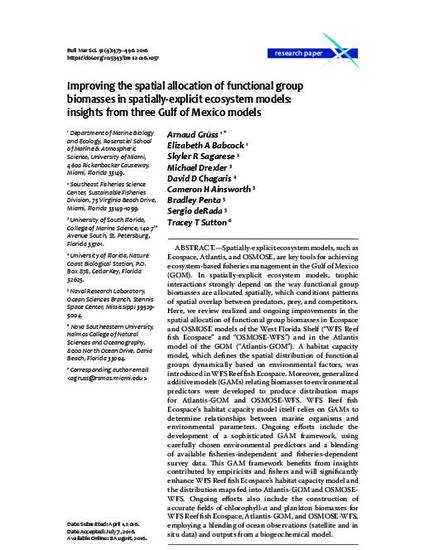
- Individual-based model,
- West Florida shelf,
- Food-web model,
- Fisheries management,
- Southern Benguela,
- Marine ecosystem,
- Exploited ecosystems,
- Fish,
- Ecosim,
- Ecopath
Spatially-explicit ecosystem models, such as Ecospace, Atlantis, and OSMOSE, are key tools for achieving ecosystem-based fisheries management in the Gulf of Mexico (GOM). In spatially-explicit ecosystem models, trophic interactions strongly depend on the way functional group biomasses are allocated spatially, which conditions patterns of spatial overlap between predators, prey, and competitors. Here, we review realized and ongoing improvements in the spatial allocation of functional group biomasses in Ecospace and OSMOSE models of the West Florida Shelf ("WFS Reef fish Ecospace" and "OSMOSE-WFS") and in the Atlantis model of the GOM ("Atlantis-GOM"). A habitat capacity model, which defines the spatial distribution of functional groups dynamically based on environmental factors, was introduced in WFS Reef fish Ecospace. Moreover, generalized additive models (GAMs) relating biomasses to environmental predictors were developed to produce distribution maps for Atlantis-GOM and OSMOSE-WFS. WFS Reef fish Ecospace's habitat capacity model itself relies on GAMs to determine relationships between marine organisms and environmental parameters. Ongoing efforts include the development of a sophisticated GAM framework, using carefully chosen environmental predictors and a blending of available fisheries-independent and fisheries-dependent survey data. This GAM framework benefits from insights contributed by empiricists and fishers and will significantly enhance WFS Reef fish Ecospace's habitat capacity model and the distribution maps fed into Atlantis-GOM and OSMOSE- WFS. Ongoing efforts also include the construction of accurate fields of chlorophyll-a and plankton biomasses for WFS Reef fish Ecospace, Atlantis-GOM, and OSMOSE-WFS, employing a blending of ocean observations (satellite and in situ data) and outputs from a biogeochemical model.
Available at: http://works.bepress.com/tracey-sutton/161/

©2016 Rosenstiel School of Marine & Atmospheric Science of the University of Miami